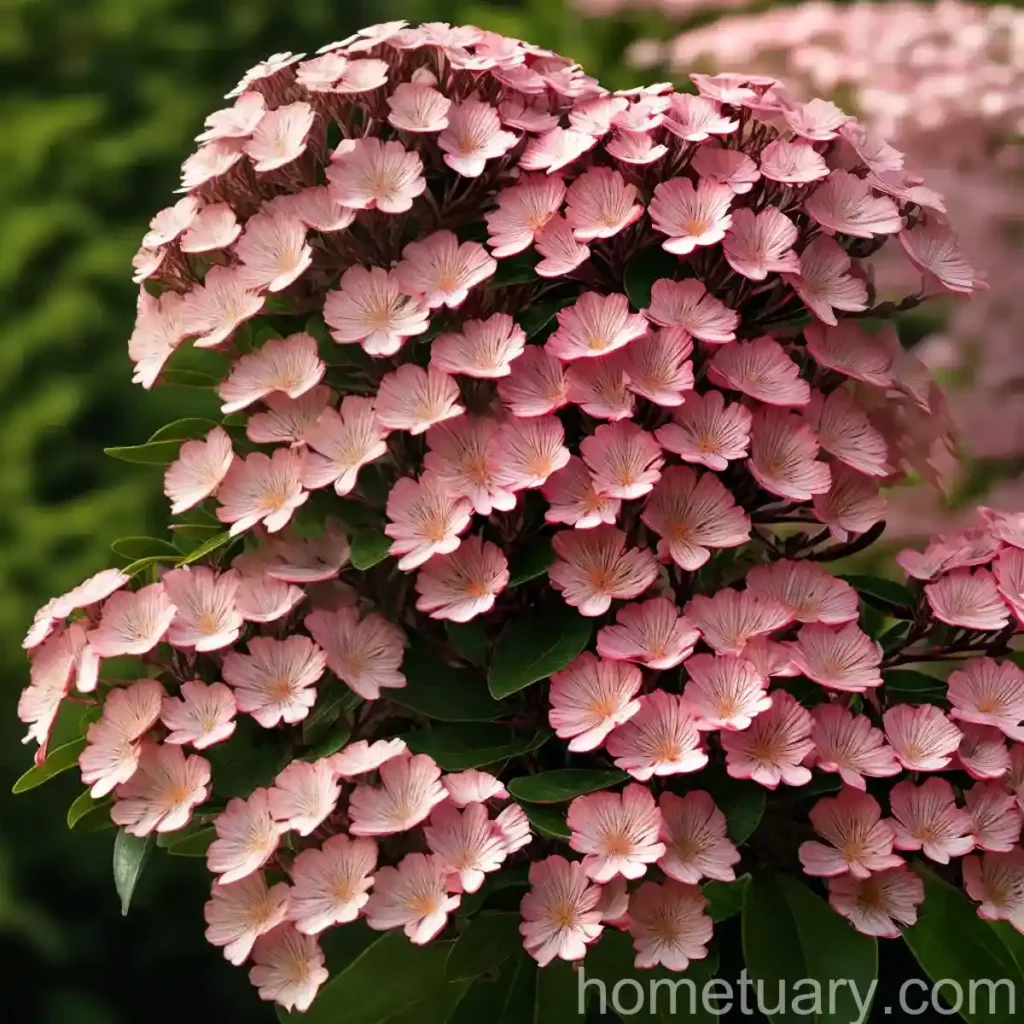The Fascinating Beauty of Mountain Laurel (Kalmia latifolia)
As a plant scientist and enthusiast, I often find myself captivated by the stunning diversity and complexity of the plant world. Among the vast variety of flora that inhabits our planet, the mountain laurel (Kalmia latifolia) stands out as a particularly captivating and intriguing species. In this comprehensive guide, we’ll explore the many facets of mountain laurel, from its cultural significance and uses to its growth requirements and the potential challenges associated with its cultivation.
What is Mountain Laurel (Kalmia latifolia)?
Mountain laurel, scientifically known as Kalmia latifolia, is an evergreen flowering shrub that belongs to the Ericaceae family. This species is native to the eastern United States, where it thrives in woodland areas and along the edges of forests. It is renowned for its exquisite blossoms, which adorn the plant with an ethereal beauty during its blooming season.
Key Takeaways – Mountain Laurel (Kalmia latifolia)
Before delving into the specific aspects of mountain laurel cultivation and care, let’s briefly outline the key takeaways related to this captivating plant.
- Scientific Name: Kalmia latifolia
- Common Names: Mountain laurel, calico bush, spoonwood
- Plant Type: Evergreen flowering shrub
- Native Range: Eastern United States
- Notable Features: Exquisite blossoms, evergreen foliage
Now, let’s embark on a journey to uncover the cultural significance, uses, and fundamental requirements for the successful cultivation of mountain laurel.
Culture
Understanding the cultural significance of mountain laurel is pivotal in appreciating its place in various historical, aesthetic, and ecological contexts. Let’s explore the cultural associations and values attributed to this venerable plant.
Ecological Significance
In its native range, mountain laurel plays a vital role in the ecological tapestry of forest ecosystems. The dense and evergreen foliage of the plant provides shelter and nesting sites for a myriad of woodland creatures, while its flowers serve as a valuable nectar source for pollinators.
Historical and Aesthetic Value
Mountain laurel has also captured the imaginations of humans throughout history, finding its way into folklore, art, and horticulture. In many regions, this plant holds a revered status and is often celebrated in local festivals and cultural events.
Uses
The versatility of mountain laurel extends beyond its ornamental appeal, as the plant has also found practical applications in various domains. Understanding its uses sheds light on the multifaceted nature of this captivating shrub.
Ornamental Plant
One of the primary uses of mountain laurel lies in its ornamental value. The exquisite blossoms and glossy foliage make it a popular choice for landscaping, garden borders, and as an accent plant in naturalistic garden settings.
Medicinal and Folklore Uses
In traditional herbal medicine, specific parts of the mountain laurel plant have been used cautiously due to its toxicity. Though its uses are rare in modern medicine, it has been employed in some herbal remedies under careful guidance.
Requirements for Growing Mountain Laurel
Successful cultivation of mountain laurel hinges upon fulfilling its specific requirements for water, sunlight, soil, and other essential factors. Let’s delve into the fundamental care guidelines that are crucial for nurturing this remarkable species.
Water
Mountain laurel typically thrives in well-drained, slightly acidic soil. Adequate moisture is essential for its success, particularly during the establishment phase and periods of extended drought. While it is generally adaptable to varying moisture levels, ensuring consistent soil moisture is key to promoting healthy growth and blooming.
Water Requirements:
– Establishment Phase: Regular watering to promote root development
– Mature Plants: Adequate moisture during dry spells, but avoid waterlogged conditions
Sunlight
In its natural habitat, mountain laurel often grows in partially shaded woodland areas, thriving under dappled sunlight. When grown in landscapes or gardens, providing it with partial shade to full sun exposure is generally ideal for its overall health and blooming performance.
Sunlight Preferences:
– Partial Shade: Ideal for most growing conditions
– Full Sun: Suitable in cooler climates and with sufficient soil moisture
Fertilizer
Given its preference for acidic soils, providing the appropriate nutrients is essential for the vigor and vitality of mountain laurel. Applying an acidic fertilizer formulated for ericaceous plants in spring or early summer can help ensure an optimal growth environment.
Fertilization Tips:
– Acidic Fertilizer: Apply in spring to early summer
– Avoid Over-fertilizing: Moderate application rates to prevent nutrient imbalances
Soil
Acidic, well-draining soil with a high organic content is critical for the success of mountain laurel. Additionally, incorporating organic matter such as peat moss or compost during planting can further enhance the soil structure and fertility.
Soil Preferences:
– Acidic pH: Optimal range of 4.5 to 6.0
– Well-Drained: Ensure adequate soil drainage to prevent waterlogging
Pruning
Pruning mountain laurel is an essential maintenance practice that contributes to its overall health, aesthetic appeal, and blooming efficiency. Regular pruning can help shape the plant, encourage new growth, and maintain a balanced form.
Pruning Considerations:
– Post-Blooming Pruning: Prune immediately after flowering to avoid disrupting bud development for the following year
– Remove Dead or Diseased Branches: Promote air circulation and prevent disease
Propagation of Mountain Laurel
To propagate mountain laurel, several methods such as seeds, cuttings, and layering can be employed. While each technique has its nuances, careful attention to detail and optimal growing conditions are paramount for a successful propagation process.
Seed Propagation
Growing mountain laurel from seeds is a rewarding but time-intensive method that requires patience and precise environmental conditions. By sowing seeds in a well-draining, acidic mix and providing consistent moisture and warmth, new plants can be grown from seeds.
Cutting Propagation
Softwood or hardwood cuttings from healthy, disease-free plants can be used to propagate mountain laurel. By providing adequate humidity, warmth, and appropriate rooting hormone, the cuttings can develop healthy root systems over time.
Mountain Laurel in Containers
The adaptability of mountain laurel makes it well-suited for container cultivation, enabling individuals with limited garden space to appreciate the allure of this remarkable plant. When grown in containers, specific care guidelines must be followed to ensure the well-being of the plant.
Popularity in Container Gardening
The compact size and aesthetic appeal of mountain laurel make it a sought-after choice for container gardening. Whether on patios, balconies, or urban spaces, its ornamental value and adaptability to container culture have contributed to its popularity.
Container Care Considerations
Growing mountain laurel in containers necessitates attentive care, particularly regarding watering, soil quality, and environmental conditions. Additionally, selecting the appropriate container size and providing adequate drainage are crucial factors in ensuring the plant’s success.
Common Diseases and Pests
Like many plants, mountain laurel is susceptible to certain diseases and pests that can potentially impact its vitality. Recognizing the symptoms and implementing timely interventions is essential in safeguarding the health of the plant.
Disease Diagnosis
Several fungal diseases, such as leaf spot and powdery mildew, can afflict mountain laurel under specific environmental conditions. Proper cultural practices, including pruning for airflow and promoting soil drainage, can mitigate the risk of these diseases.
Common Pests
Pests such as lace bugs and spider mites may pose a threat to mountain laurel, particularly in stressed or suboptimal growing conditions. Monitoring for pest activity and employing targeted control measures when necessary can help preserve the plant’s well-being.
Botanist’s Tips for Mountain Laurel
Based on my research and experience, I’ve compiled a set of practical tips to guide both novice and seasoned gardeners in cultivating and appreciating mountain laurel to its fullest potential.
Botanist’s Recommendations
- Promote Soil Health: Maintain acidic soil conditions and incorporate organic matter for optimal growth
- Aim for Consistent Moisture: Monitor soil moisture levels to prevent drought stress while avoiding waterlogged conditions
- Prune with Precision: Implement post-blooming pruning and remove diseased branches to foster the plant’s long-term health
Fun Facts about Mountain Laurel
To deepen our understanding and appreciation of this remarkable plant, let’s uncover some intriguing and delightful facts about mountain laurel.
Did You Know?
- The mountain laurel plant, adorned with striking blossoms, has earned the title of being Pennsylvania’s state flower.
- In certain Native American folklore, mountain laurel is associated with stories of love, rebirth, and spiritual symbolism.
Links to External Resources
In this section, I have curated a selection of reputable resources and references that offer valuable insights and guidance for individuals interested in exploring mountain laurel further.
- The United States Department of Agriculture (USDA) Plant Database
- North Carolina State University Cooperative Extension
- The American Rhododendron Society
- University of Connecticut Plant Database
In conclusion, mountain laurel exemplifies the captivating beauty and remarkable adaptability of the plant kingdom. Its enchanting blossoms, evergreen foliage, and cultural significance make it a plant of immense value and admiration. By embracing the insights and care guidelines outlined in this guide, enthusiasts and horticultural practitioners can discover the enduring allure of this remarkable species and cultivate it with confidence and appreciation.
Would you like to learn more about a specific aspect of mountain laurel cultivation or explore other plant species with fascinating attributes? Feel free to reach out with any questions or topics you’d like to explore further!















